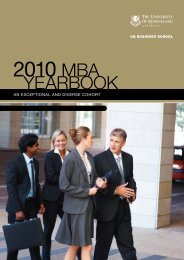Modelling the accruals process and assessing unexpected accruals*
Modelling the accruals process and assessing unexpected accruals*
Modelling the accruals process and assessing unexpected accruals*
You also want an ePaper? Increase the reach of your titles
YUMPU automatically turns print PDFs into web optimized ePapers that Google loves.
insights into what <strong>unexpected</strong> <strong>accruals</strong> actually capture, what determines <strong>the</strong> direction <strong>and</strong> <strong>the</strong><br />
magnitude of <strong>the</strong>ir bias or contamination, <strong>and</strong> why such a bias or contamination arises.<br />
I begin by adopting <strong>the</strong> idea in Richardson et al. (2005) to comprehensively measure <strong>accruals</strong> by<br />
subtracting <strong>the</strong> income under cash accounting from <strong>the</strong> income under accrual accounting. In<br />
addition to <strong>the</strong> balance sheet approach provided in Richardson et al. (2005), I also consider <strong>the</strong><br />
income statement approach to calculate <strong>accruals</strong> under clean surplus accounting. This<br />
reconciliation offers insight into <strong>the</strong> conclusion in Hribar <strong>and</strong> Colins (2002) that <strong>the</strong> <strong>accruals</strong><br />
calculated under both methods are different.<br />
With this <strong>accruals</strong> definition in mind, I first model normal <strong>accruals</strong> as <strong>the</strong> <strong>accruals</strong> resulting from<br />
<strong>the</strong> neutral accrual <strong>process</strong> that shifts cash flow recognition in income to a time that unbiasedly<br />
reflects underlying fundamentals. As <strong>the</strong> sum of accrued <strong>and</strong> deferred components, normal<br />
<strong>accruals</strong> are driven by growth in income <strong>and</strong> changes in <strong>accruals</strong> <strong>and</strong> deferrals policies. Second, I<br />
model abnormal <strong>accruals</strong> as <strong>the</strong> <strong>accruals</strong> that distort <strong>the</strong> neutral <strong>accruals</strong> <strong>process</strong> by accelerating<br />
<strong>and</strong>/or delaying cash flow recognition in income. The two factors that drive abnormal <strong>accruals</strong><br />
are a change in accounting policy <strong>and</strong> forward income growth. Finally, I combine <strong>the</strong> normal <strong>and</strong><br />
abnormal <strong>accruals</strong> into <strong>the</strong> final <strong>accruals</strong> model under clean surplus accounting.<br />
My model is appealing in that it does not impose restrictive assumptions on firms‟ fundamentals.<br />
It merely requires (a) <strong>the</strong> basic accounting identity to hold, (b) <strong>accruals</strong> to alter <strong>the</strong> timing of cash<br />
flow recognition in income over time, <strong>and</strong> (c) <strong>the</strong> aggregated income to be equal to <strong>the</strong><br />
aggregated cash flow over <strong>the</strong> life span of firms. These three conditions can hardly be regarded<br />
3



